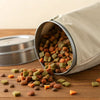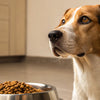Should You Put Water in Dry Dog Food? A Comprehensive Guide for Pet Owners
- Houndsy
Table of Contents
- Introduction
- Understanding Dry Dog Food
- The Pros of Adding Water to Dry Dog Food
- The Cons of Adding Water to Dry Dog Food
- Tips for Adding Water to Dry Dog Food
- Conclusion
Introduction
As dog owners, we strive to give our furry companions the best care possible. A fascinating statistic to consider is that many dogs do not drink enough water daily, leading to potential dehydration and health issues. This brings us to a common question: should you put water in dry dog food? This blog post explores the ins and outs of this practice, helping you make an informed decision about your dog’s diet and hydration needs.
By the end of this article, you will gain insights into the benefits and drawbacks of adding water to dry kibble, tips for doing so effectively, and how this practice might fit into your overall feeding routine. We’ll also reflect on our experiences as pet owners and how simple modifications can enhance our beloved dogs’ feeding experiences. Let’s dive deep into this topic and discover how we can better cater to our four-legged friends.
Understanding Dry Dog Food
The Basics of Kibble
Dry dog food, commonly known as kibble, has become a staple in canine diets due to its convenience, affordability, and shelf stability. Kibble is typically composed of a blend of meat, grains, vegetables, and essential nutrients, all formulated to provide a balanced diet for dogs. However, while kibble has its advantages, it can also pose certain challenges, particularly concerning hydration and palatability.
Nutritional Composition
Kibble is designed to ensure dogs receive the necessary nutrients for their overall health. However, it often contains a high percentage of carbohydrates and requires sufficient water intake for optimal digestion. This leads us to the pivotal question: can adding water to kibble improve its nutritional benefits, or could it create more problems than it solves?
The Pros of Adding Water to Dry Dog Food
Enhanced Palatability
One of the primary benefits of adding water to dry dog food is increased palatability. Many dogs find moistened kibble more appealing, as the added moisture can enhance the food's aroma and flavor. This is especially beneficial for picky eaters or dogs recovering from illness who may have a reduced appetite. By transforming a mundane meal into a more enticing dish, we can encourage our dogs to eat better and enjoy their meals more.
Improved Hydration
Adding water to dry dog food can significantly boost hydration, which is crucial for maintaining your dog's overall health. Dogs, especially those who are less inclined to drink water, can benefit from this practice. The moisture in the food can help ensure that they meet their daily hydration needs, reducing the risk of dehydration-related health issues.
Easier Digestion
Moistening kibble can aid in digestion, particularly for senior dogs or those with dental issues. Water softens the kibble, making it easier to chew and swallow. This benefits dogs with sensitive stomachs or those who struggle with hard kibble. The gentler texture can also help reduce the risk of digestive upset, leading to a more comfortable meal experience.
Dental Health Considerations
For dogs with dental problems, adding water to their kibble can provide a tooth-friendly alternative. Softened food is less likely to cause discomfort and allows them to eat without struggling. While dry kibble is often touted for its ability to scrape plaque off teeth, it may not be suitable for all dogs, particularly those with existing dental issues.
The Cons of Adding Water to Dry Dog Food
Potential for Spoilage
One of the primary concerns about adding water to kibble is the potential for spoilage. When kibble is soaked and left out for too long, it can create an ideal environment for bacterial growth. This can lead to gastrointestinal upset and other health issues. To mitigate this risk, it’s essential to serve moist kibble immediately and discard any uneaten portions after about 60 minutes.
Impact on Dental Health
While softening kibble can help dogs with dental issues, it may reduce the benefits of dry kibble in terms of dental health for dogs with healthy teeth. The crunchiness of dry kibble helps scrape away plaque and tartar, so soaking it may diminish this protective effect. For dogs that do not have dental concerns, it may be better to stick to dry kibble to maintain optimal oral hygiene.
Nutritional Loss
Adding water to kibble could potentially alter its nutritional profile. Some vitamins and minerals may leach out into the water, especially if the kibble is allowed to soak for an extended period. This can lead to a decrease in the overall nutritional value of the meal. It’s important to consider the quality of the kibble being used and consult with a veterinarian regarding the best practices for your dog's diet.
Overeating Risks
Another concern is that moistening kibble can lead to overeating. The enhanced flavor and easier texture may encourage dogs to eat more quickly or consume larger portions. This can lead to weight gain and associated health issues, particularly in dogs that are already prone to overeating. Monitoring portion sizes and adjusting feeding habits is crucial when introducing water to kibble.
Tips for Adding Water to Dry Dog Food
Start Slowly
If you decide to add water to your dog’s kibble, it’s best to start slowly. Gradually introduce a small amount of water to the kibble to allow your dog to adjust to the new texture. This will help you gauge their response and minimize any digestive issues.
Use Warm Water
Using warm (not hot) water can help release the aromas and flavors of the kibble, making it even more enticing for your dog. Warm water can enhance the overall eating experience and encourage your dog to eat their meal promptly.
Serve Immediately
To reduce the risk of spoilage and bacterial growth, serve the moistened kibble immediately. Avoid leaving it out for extended periods, especially in warmer weather. Any uneaten portion should be discarded promptly.
Monitor Your Dog's Response
As with any dietary change, it's important to monitor your dog’s response. Watch for any signs of digestive distress or changes in appetite. If you notice any adverse effects, consider adjusting the amount of water added or discontinuing the practice altogether.
Conclusion
In summary, the decision to add water to dry dog food largely depends on your dog's individual needs and preferences. Adding water can enhance palatability, improve hydration, and make meals easier to digest, especially for dogs with specific health concerns. However, there are potential downsides, including spoilage, reduced oral health benefits, nutritional loss, and the risk of overeating.
Ultimately, our mission at Houndsy is to simplify and elevate the dog feeding experience, making it convenient, consistent, and beautiful. If you’re looking for a product that enhances your dog’s feeding routine, we encourage you to explore the Houndsy Kibble Dispenser. Our innovative design combines form and function, ensuring perfect portions every time while complementing your home decor.
As you reflect on your dog's feeding habits, consider whether adding water aligns with their unique needs. Always consult with your veterinarian if you're unsure about dietary modifications or if you have any concerns regarding your dog’s health and nutrition.
FAQ
1. Is it safe to add water to my dog's kibble?
Yes, it is generally safe to add water to your dog’s kibble. However, it’s important to monitor how your dog responds and to serve the moistened food immediately to prevent spoilage.
2. How much water should I add to dry dog food?
Start with a small amount, such as a quarter cup for a regular serving of kibble, and adjust based on your dog's preferences and needs.
3. Can adding water to kibble help with my dog’s hydration?
Yes, adding water can help increase your dog's overall hydration, which is particularly beneficial for dogs that do not drink enough water on their own.
4. Will adding water to kibble affect its nutritional value?
Adding water to kibble may lead to a loss of some nutrients, especially if the kibble is allowed to soak for a long time. It’s essential to ensure your dog’s diet remains balanced.
5. How can I prevent spoilage when adding water to kibble?
To prevent spoilage, serve the moistened kibble immediately and discard any leftovers after about 60 minutes. Avoid leaving it out at room temperature for extended periods, especially in warm weather.












